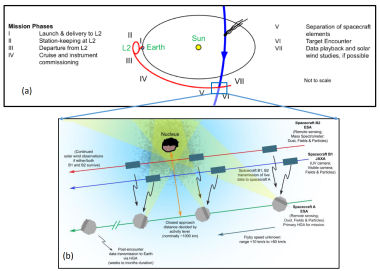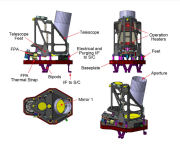 |
 |
 |
| Missions
|
||
         |
Comet
Interceptor Comet Interceptor is an exciting new mission that will be launched before its target is known. The mission is foreseen for launch as co-passenger with ESA’s ARIEL spacecraft. Both missions will be delivered to the Sun-Earth Lagrange point L2, Comet Interceptor will wait at L2 point in space until a new Long Period Comet (LPC) is identified on its way into the inner Solar System. ARIEL is the first mission dedicated to measuring the chemical composition and thermal structures of hundreds of transiting exoplanets, enabling planetary science far beyond the boundaries of the Solar System. At L2 point, Comet Interceptor will set off to make a flyby of the comet, and make new discoveries about its properties. Previous comet missions VEGA, Giotto and Rosetta, encountered short-period comets. These are comets with orbital periods of less than 100 years that have approached the Sun many times along their orbits in relatively recent times and as a consequence have undergone significant changes: Rosetta's comet, 67P/Churyumov-Gerasimenko orbits the Sun once every 6.5 years while Comet 1P/Halley, visited by VEGA, Giotto and other spacecraft in 1986, returns to our skies every 76 years. LPCs are differents from already observed comets because they are messengers from the dawn of the solar system and will tell us about how the solar system formed even an interstellar object that is only just starting its journey into the inner Solar System so it is pristine comet. Comet Interceptor was chosen by ESA in June 2019. It is the first of the so-called 'Fast-class' missions in the Cosmic Vision programme and it is now undergoing development by the agency, in cooperation with the Japanese Aerospace Exploration Agency (JAXA), for launch in 2029. It will be a multi-element spacecraft comprising a primary platform (A), which also acts as the communications hub, and two sub-spacecraft (B1 built by JAXA and B2 built by ESA), allowing multi-point observations around the target. All spacecraft will be solar powered. The spacecraft will remain connected to each other at L2. The mission cruise phase will last months to years. Before the encounter, the spacecraft will separate into its separate elements. This will be the first to visit a LPC. As such, the comet will contain material that has not undergone much processing since the dawn of the Sun and planets. The mission will therefore offer a new insight into the evolution of comets as they migrate inwards from the periphery of the Solar System. Each spaceprobe will be equipped with a complementary science payload, providing different perspectives of the comet's nucleus and its gas, dust, and plasma environment. Such 'multi-point' measurements will greatly improve the 3D information needed to understand the dynamic nature of a pristine comet while it is interacting with the constantly changing solar wind environment. The spacecrafts will carry following instruments: Comet Interceptor A (ESA)
The SGF Co.
Ltd.participating in the
development of Comet Camera system (CoCa) which willo CoCa:: Visible/near-infrared imager o MIRMIS: NIR/Thermal IR spectral imager o DFP: Dust, Fields and Plasma sensor Comet Interceptor B1 (JAXA) o HI: Lyman-alpha Hydrogen Imager o PS: Plasma Suite o NAC/WAC: Narrow Angle Camera/ Wide Angle Camera Comet Interceptor B2 (ESA) o OPIC: Optical Imager for Comets (Vis/IR) o MANIaC: Mass Analyzer for Neutrals and Ions at Comets (mass spectrometer) o EnVisS: Entire Visible Sky coma mapper o DFP: Dust, Fields and Plasma sensor make snapshott on nucleus of pristine comet visiting first time to Sun. The task of our team is to prepare the software to controll the CoCa system as well as to transfer the pictures of the newly appeared on comet. SGF Ltd. developed a similar software system of the color stereo camera (CaSSIS) for ExoMars mission, which was developed too with lead by the Planetary Imaging Group from Bern University. |
 Simplified Drawing of the encounter (Credit ESA)  Mockup of Comet Interceptor (A, B1 and B2) (Credit ESA)  Comet Camera (Credit UNIBE) |